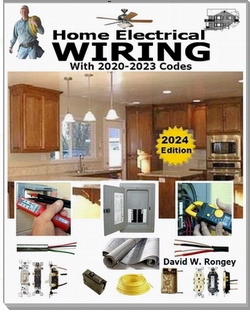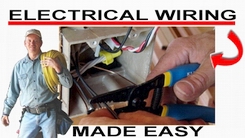220 Volt Range CircuitAdding a 220 Volt Range CircuitI have a gas range that I'm replacing with an electric range. As you might expect, there is no 220 wiring behind the stove, so I'm going to have to run new wiring. It's not going to be an easy task as this is on an exterior wall and it is finished above and below, and I have cabinets on either side. I'm trying to decide whether to go with a flush-mount or surface mount. Last time I tried to install a flush mount with 6 gauge wire, it was a nightmare to get the receptacle back into the box (wires too stiff). Your advice? Del, oh how I know your situation. I would go with surface mount, just keep the receptacle box low and angle the outlet for a side plug configuration. You may be able to conceal the surface conduit inside the cabinets, and install flex for a easier installation. Consider a 5-Square or 4 11/16 metal box to provide room for the wire, and mount the receptacle in a raised industrial cover. |
» Need Electrical Help? Ask the Electrician
220 Volt Outlet Problem

|
By Dave Rongey
© By: Dave Rongey |
How to Wire a 220 Volt Leviton Outlet from a Square-D Panel
Electrical Outlets Question:
I'm having a problem with wiring a 220 volt outlet (a Leviton Model 5823 NEMA 6-20R receptacle).
Double Pole Breaker
I installed a 20 amp double pole breaker in my panel, and I ran 12/2 wire with a ground to the outlet. On the breaker, I connected the white and black wires to each pole, and connected the bare copper wire to ground.
Wiring the 220Volt Outlet
At the outlet, I connected the bare copper wire to ground (the green terminal), and I connected the white wire to one side, and the black wire to the other. When testing with a volt meter, if I put one terminal on ground and one terminal on either pole, I get 110 volts.
If I put both terminals on the poles, I get nothing. Aren't I supposed to be getting 220? The bottom line is that the 220 volt heater that I bought isn't working when I plug it in.
Electric Heater Circuit Requirements
The heater is single phase, so I didn't think it mattered which side I connected the black and white wires to. Regardless, the heater still doesn't work if I reverse them.
At first, I thought the heater might be defective, so I exchanged it for another one, but the new one doesn't work either. Obviously, there's something wrong with the way I wired the outlet.
Can you help?
Patrick D.
Hi Patrick - Great Electrical Repair Question!
It sounds like the two breakers are attached to the same buss, so your only getting the 110 volt reading. This can happen if you are using a Twin Breaker. If this is the case then you need to use a full size 2-pole breaker. If you are using a full size 2-pole breaker then for some reason your panel is not getting both hot legs.
Check the Ciruit Voltage
You need to check this and let me know what you find. Check anywhere in the panel across two hot legs to see if you get a 220 volt reading. If you don't get a 220 volt reading you'll have to find out what feeds the panel you are at and see if it is wired right or there may be another problem. We wont get into that right now, lets just take it one step at a time and check the panel where the heater circuit originates from.
From Patrick D.
Ok, we're on the right track. I'm wiring to a sub panel that's in my garage and I've attached a picture of it.
Testing the Wires
If I take my volt meter and connect it to the red and black supply wires, I'm getting 220 volts.
20 Amp Breaker
If you look at that 20 amp double pole breaker on the right, that's what I'm wiring my outlet to. If I touch the volt meter leads to each pole of the breaker, I get nothing. One lead to a pole and one lead to ground, I get 110 on each pole.
Ok, I killed the power to this sub panel before I started messing around in it. When I bought this double pole breaker to do this little project, I noticed that it only had one metal clip at the bottom, but the whole box of breakers where I bought it were like this, so I didn't think much of it. Is this normal?
I've attached a picture of the panel with the breaker out as well as a picture of the back of the breaker.
From Dave:
OK - What you need to do is careful pull the 2-pole breaker out and make sure you have two exposed busses available for your breaker to attach to. If you do have both busses exposed then you may have a bad breaker.
Let me know what you find out. Be Careful!
Dave
Pat,
I looked at the pics closer and I think I see the black wire loop up and then down into the right hand lug - so if this is the case it is ok. Then from the looks of this panel you may only be able to have one 2-pole breaker that actually gives 220 volts and I'll bet that it will be the center two spaces. You would know this by pulling out the two center breakers and see that the busses are separated.
From: Patrick D.
You da man!
Attached is a picture of the panel with all the breakers out. I put the double pole breaker right there in that middle spot, and viola! It works!
Thanks for all your help.
Thanks, Dave!
From Dave:
That's great news!
Square-D Breaker Panel
I even discussed this with one of my Sq-D Suppliers. He insisted that your panel should not have had two breaker spaces where the buss was from the same leg. This is an odd panel. I will share this with him.
Thanks for the compliment.
Oh - by the way, you really should place knock out seals in the open areas of your panel to keep it closed up and from any unwanted things from going inside. I have the wildest picture of a mouse that snuggled up a little too close to the main buss in a panel - cooked the little guy!
Thanks Again!
The Safest Way to Test Electrical Devices and Identify Electric Wires!The Non-Contact Electrical TesterThis is a testing tool that I have had in my personal electrical tool pouch for years, and is the first test tool I grab to help identify electrical wiring. It is a Non-contact tester that I use to easily Detect Voltage in Cables, Cords, Circuit Breakers, Lighting Fixtures, Switches, Outlets and Wires. Simply insert the end of the tester into an outlet, lamp socket, or hold the end of the tester against the wire you wish to test. Very handy and easy to use.
The Quickest Way to Check for Faulty Electrical Wiring!The Plug-In Outlet TesterThis is the first tool I grab to troubleshoot a problem with outlet circuit wiring. This popular tester is also used by most inspectors to test for power and check the polarity of circuit wiring. It detects probable improper wiring conditions in standard 110-125 VAC outlets Provides 6 probable wiring conditions that are quick and easy to read for ultimate efficiency Lights indicate if wiring is correct and indicator light chart is included Tests standard 3-wire outlets UL Listed Light indicates if wiring is incorrect Very handy and easy to use.
Strip Off Wire Insulation without Nicking and Damaging the Electric Wire!The Wire Stripper and Wire CutterMy absolute favorite wire stripping tool that I have had in my personal electrical tool pouch for years, and this is the tool I use to safely strip electrical wires. This handy tool has multiple uses: The wire gauges are shown on the side of the tool so you know which slot to use for stripping insulation. The end of the tool can be used to grip and bend wire which is handy for attaching wire onto the screw terminals of switches and outlets.. The wire stripper will work on both solid and stranded wire. This tool is Very Handy and Easy to Use. |
||
Outlets Parts and Accessories120volt Wall Outlet GFCI Outlet Switch and Outlet Combo |














